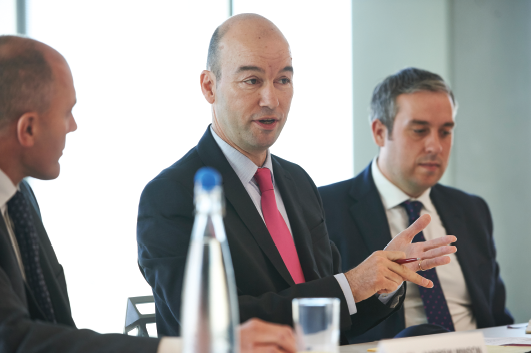
Redefining sustainability for today and the future
As the definition of sustainability has grown and diversified in recent years, the time is now right to bring together the various disciplines across the built environment to harmonise and redefine sustainability.
In the December 2016 issue of ABC+D Magazine, Martin Hurn, brand director at Ecobuild, discusses how to achieve this, following the show’s recent roundtable on how manufacturers can respond to the changing environment and help shape the future of sustainability…
The definition of sustainability is becoming increasingly multifaceted. It is no longer limited to low carbon construction and now includes a range of factors such as wellbeing, placemaking and infrastructure.
While the increasingly broad reach of the concept and its continuing prominence can only be a seen as a positive development, the expansion and divergence in the understanding of sustainability across the built environment has begun to create a new challenge in terms of driving the sustainability agenda forward and creating common goals for the future.
To tackle this, Ecobuild launched the Redefining Sustainability campaign. The aim of the campaign is to bring together the various meanings of sustainability from across the construction industry and, ultimately, arrive at a universally accepted definition that is appealing, engaging and accessible to all.
The manufacturers’ perspective
Manufacturers, suppliers, specifiers and installers, as well as academics and policy makers, have all made an impassioned contribution across a range of activities, including blogs, roundtables, ballot boxes and webinars.
Given that the construction products industry undoubtedly plays a crucial role in shaping the agenda, Ecobuild recently hosted a roundtable to discuss how they can respond to the changing environment and help shape the future direction – and definition – of sustainability. The event formed the second roundtable in Ecobuild’s ongoing programme of activities on the topic, ahead of the 2017 show.
Attendees included Peter Caplehorn, deputy chief executive of Construction Products Association; Michael Sansom, associate director, sustainability, of The Steel Construction Institute; Rob Warren, head of technical for Celotex, part of Saint-Gobain group; Martin Crow, senior sustainability manager, Hanson UK and Rupert Scott, marketing and membership director, Timber Research And Development Association (TRADA), among other experts.
Connecting with the end consumer
Establishing a connection with the end consumer, i.e. home owners and building occupants, was identified as a key challenge during the discussion. TRADA’s Rupert Scott pointed out that “the sector lags behind others in working out what the consumer demands.”
It was noted that while part of the solution lies in exploring ways of communicating directly with the end customer and tapping into their needs and priorities, when considering the built environment, customers are not necessarily bothered by the components of the building but the whole building. Celotex’s Rob Warren suggested that customers are most concerned about living in a building that “does its job, is healthy and comfortable”.
Incentivising green behaviour
This led into an interesting debate about incentivising green behaviour. It was highlighted that, currently, consumers place greater importance on issues such as the quality of local schools and house price, rather than the energy efficiency of a property, creating an opportunity to reward green behaviour.
Rob Warren proposed that if, for instance, people were given an incentive “to link EPCs to council tax band, people might want to do something greener to their houses.”
Key findings
Sharing knowledge and better education across the industry around long-term sustainability benefits – cost savings, building performance and longevity – was accepted as the best way forward and vital in paving the way for a more sustainable future.
Where next?
The sustainability debate will certainly continue well into the future. However, what is clear is that we, as an industry, must push forward to create a single definition of sustainability that applies to and is achievable for all. This means a shift in focus from products and technology, towards people, places and real-life benefits.
Latest news

18th April 2024
Abloy UK showcases new digital portfolio at The Security Event 2024
Abloy UK is set to unveil its latest line-up of access control systems at The Security Event 2024, welcoming guests to explore its cutting-edge electromechanical and digital solutions on stand 5/F50.
Posted in Access Control & Door Entry Systems, Architectural Ironmongery, Articles, Building Industry Events, Building Industry News, Building Products & Structures, Building Services, Doors, Exhibitions and Conferences, Facility Management & Building Services, Health & Safety, Information Technology, Retrofit & Renovation, Security and Fire Protection
18th April 2024
Strand is a Failsafe Choice for Emergency Exit and Panic Hardware
In times of emergency, you’re in safe hands with Strand Hardware. Although there are many considerations for building specification, few decisions can be as critical as selecting the right emergency exit/panic hardware.
Posted in Access Control & Door Entry Systems, Architectural Ironmongery, Articles, Building Industry News, Building Products & Structures, Building Services, Doors, Facility Management & Building Services, Health & Safety, Restoration & Refurbishment, Retrofit & Renovation, Security and Fire Protection
18th April 2024
MRA appoints Callum Budd as Research Projects Director
MRA Research, the research agency focused solely on the construction sector, welcomes Callum Budd as its new Research Projects Director.
Posted in Articles, Building Industry News, Information Technology, news, Recruitment, Research & Materials Testing
16th April 2024
Mitsubishi Electric set to host CIBSE Journal webinar
Mitsubishi Electric will host a CIBSE Journal webinar on Wednesday 24th April 2024 at 1pm to discuss the legislation and initiatives driving changes in the way we will need to heat, cool and ventilate large commercial buildings to reach net zero emissions in the UK.
Posted in Air Conditioning, Articles, Building Industry Events, Building Industry News, Building Products & Structures, Building Regulations & Accreditations, Building Services, Facility Management & Building Services, Heating Systems, Controls and Management, Heating, Ventilation and Air Conditioning - HVAC, Information Technology, Pipes & Fittings, Plumbing, Seminars, Sustainability & Energy Efficiency, Training
 Sign up:
Sign up: 